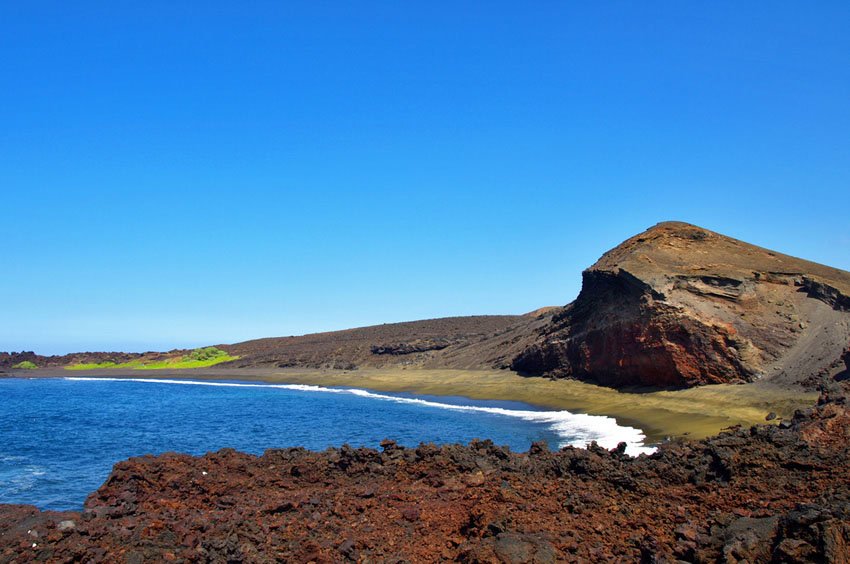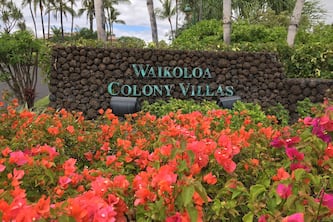Road to the Sea Black Sand Beach

Road to the Sea Black Sand Beach, Big Island
The Road to the Sea, located on the Big Island's southwestern coast, is one that's hardly traveled, and it's easy to see why. The six-mile (9.7 km) trail is dotted with sharp lava rocks, surrounded by steep ledges and riddled with cracks and potholes. But those who make it here are well-rewarded, for at the end of this path lie a few black and green sand beaches that are surrounded by nothing but black lava rocks. On a sunny day, the coast looks picture-perfect with its greenish sand, deep blue waters and the surrounding black cliffs.
But getting here is definitely an adventure in itself. The first 3 miles (4.8 km) of the road are doable even in a regular car, but after that the road is rough and steep in places, so a four-wheel drive vehicle is necessary to navigate it (or you can park here and hike the final 3 miles to the beach).
It's commonly called the Road to the Sea Black Sand Beach, but there are actually two beaches at the end of the road. Neither has an official name, but both are known for their black and green sands. The green comes from crushed olivine crystals, a less-polished variety of peridot. It is a semi-precious gemstone, brought to the surface by past volcanic activity and the erosive force of the ocean. The ancient Hawaiians considered olivine (green sand) to be the tears of the volcano goddess Pele, and they used the green sand in healing ceremonies. The sand pieces are too small to be considered gemstones, but occasionally a lucky beachgoer finds a bigger piece.
The two beaches are fairly small, between 50 and 100 feet (15-30 m) long. The green sand has a slightly darker hue here than at Papakolea Beach (near South Point), which is the most popular green-sand beach on the Big Island. There are no lifeguards in this area, so if you want to swim, snorkel or surf, keep in mind that the ocean bottom drops off quickly and strong currents can be present, especially during times of high surf. Fishing is a popular activity here, especially in the spring and summer when the fish swim closer to shore. The main catch is ulua.
Key Features of Road to the Sea Black Sand Beach
- Remote adventure destination: A 6-mile rugged lava trail leads to two secluded beaches with black and green sand.
- Unique green sand: Formed from olivine crystals, the sand has spiritual and geological significance in Hawaiian culture.
- Challenging access: Only accessible by 4WD or hiking the last 3 miles on rough, unmaintained terrain.
- Unspoiled landscape: Surrounded by lava cliffs and untouched coastal views - no facilities or crowds.
- Fishing hotspot: Ulua fishing is popular in spring and summer when fish swim close to shore.



The street sign has been removed from the entrance on 11, a sign that locals are keeping tourists out.
Asking directions at a local store resulted in "No beach out there".
Summary - one of the best spots to enjoy a peaceful day at a green sand beach without the crowds. Bring your beverages because there is nothing out there but you. Also, a truck is in the surf where an old path wound by the sea. Avoid that trail...
Frequently Asked Questions
Do I need a 4WD to reach Road to the Sea?
Yes. The final 3 miles of the trail are rugged and only navigable by four-wheel drive. Alternatively, you can hike the rest of the way.
Is it safe to swim at the beach?
Swimming is not recommended due to strong currents and steep ocean drop-offs. There are no lifeguards on site.
What causes the green sand at this beach?
The green hue comes from olivine crystals, a mineral brought to the surface by volcanic activity and shaped by ocean erosion.
Is fishing allowed?
Yes, fishing is popular here - especially for ulua. Just bring your own gear and note there are no nearby shops or services.















